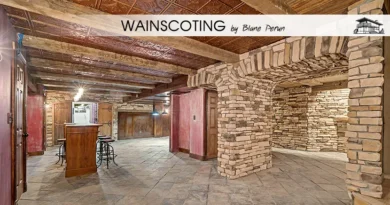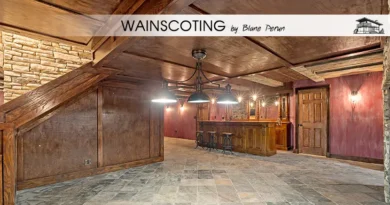Wainscoting
Elevating Your Space: The Wainscoting Way
When it comes to adding a touch of elegance and character to your home, wainscoting is a design element that speaks volumes. This architectural feature, which involves paneling the lower part of walls, has a rich history and offers both aesthetic and practical benefits. Traditionally used in the 18th century to insulate and protect walls, wainscoting has evolved into a decorative statement that can transform any room from ordinary to extraordinary.

The Aesthetic Appeal of Wainscoting
The Timeless Elegance of Panel Styles
Wainscoting isn’t just about adding panels to your walls; it’s about bringing a piece of history and elegance into your home. The style of panel you choose, be it beadboard, raised panel, or flat panel, can dramatically alter the look and feel of a room. Beadboard, with its vertical lines, offers a casual, cottage-like vibe, perfect for kitchens and bathrooms. Raised panels, with their rich depth and shadow lines, bring a more formal and sophisticated air, ideal for dining rooms and libraries. Each style has its unique charm and historical significance, adding layers of depth to your interior design.
The Art of Paint and Finish
The choice of paint and finish plays a crucial role in the overall impact of wainscoting. Whether you opt for a crisp white to brighten a room or a bold color to make a statement, the finish can enhance the texture and detail of the paneling. A high-gloss finish can reflect light and add a touch of glamour, while a matte finish might contribute to a more subdued, classic look. Understanding the interplay of light, color, and finish can help you achieve the desired ambiance in your space.
Practical Benefits and Installation Insights
Enhancing Room Durability and Maintenance
Beyond its aesthetic appeal, wainscoting offers practical benefits that make it a wise investment for homeowners. It serves as an additional layer of protection for your walls, safeguarding against scuffs, dents, and wear in high-traffic areas. This durability aspect is especially beneficial in spaces like hallways and dining areas, where walls are more susceptible to damage. Moreover, wainscoting is relatively easy to clean and maintain, ensuring that your walls remain pristine and stylish for years to come.
Installation Techniques and Considerations
Installing wainscoting can be a rewarding DIY project or an endeavor that requires professional expertise, depending on the complexity of the design and the specific needs of your space. Key considerations include the type of material (wood, MDF, PVC), the height of the paneling, and the integration with existing architectural elements such as doorways and windows. Proper planning and execution are crucial to achieving a seamless and polished look that enhances the overall aesthetic of your home.
The Role of Wainscoting in Modern Design
Integrating with Contemporary Decor
Wainscoting can beautifully complement contemporary design schemes, bridging the gap between traditional elegance and modern simplicity. By pairing clean-lined paneling with minimalist decor, you can create a space that feels both timeless and current. The versatility of wainscoting allows it to adapt to various design trends, making it a lasting choice for homeowners looking to elevate their interiors.
Sustainable and Eco-Friendly Options
As sustainability becomes increasingly important in home design, eco-friendly materials for wainscoting are gaining popularity. Options like reclaimed wood or sustainable MDF provide a responsible choice for environmentally conscious homeowners. These materials not only contribute to the health of the planet but also add a story and depth to your home’s design, combining beauty with responsibility.
In conclusion, wainscoting is more than just a decorative feature; it’s a versatile design element that offers both beauty and practicality. Whether you’re drawn to its historical roots, the elegance it adds to any room, or its protective benefits, wainscoting can transform your space in myriad ways. By considering factors such as style, finish, and material, you can integrate wainscoting into your home in a way that complements your personal aesthetic and meets your practical needs.

FAQs on Wainscoting
What is the best material for wainscoting in a humid environment? In humid environments, materials like PVC or high-grade MDF are ideal for wainscoting because they resist moisture and won’t warp or swell like natural wood can. PVC offers excellent durability and water resistance, making it perfect for bathrooms and kitchens.
Can wainscoting increase home value? Yes, wainscoting can potentially increase home value by enhancing the architectural detail and aesthetic appeal of your interior spaces. High-quality wainscoting in key areas like dining rooms and entryways can make a home more attractive to potential buyers.
How do I choose the right height for my wainscoting? The height of wainscoting should be one-third the height of the room for traditional proportions, typically between 32 to 36 inches for standard ceilings. However, for a more modern look or in rooms with high ceilings, you might consider extending the wainscoting higher, up to 48 inches or more. It’s essential to consider the scale and proportion of your space, as well as the architectural details, to achieve a balanced look.
Is wainscoting suitable for every room in the house? Wainscoting can be adapted to suit almost any room in the house, from living areas and dining rooms to bedrooms and bathrooms. The key is selecting the right style and material for the specific room’s function and moisture levels. For instance, beadboard wainscoting is popular in bathrooms for its resistance to moisture and ease of cleaning.
How does wainscoting impact the perceived size of a room? Wainscoting can influence the perceived size and proportion of a room. Light-colored wainscoting can make a room feel larger and brighter, especially when paired with a contrasting wall color above. Conversely, dark-colored wainscoting can add depth and warmth to a space, making large rooms feel cozier. The vertical lines of certain styles, like beadboard, can also create the illusion of higher ceilings.
Incorporating wainscoting into your home design not only enhances its visual appeal but also adds a layer of durability and charm. Whether you’re aiming for a classic, elegant look or a modern twist, wainscoting offers a range of options to suit your style and needs. With its blend of form and function, wainscoting remains a favored choice for homeowners looking to elevate their interiors.





